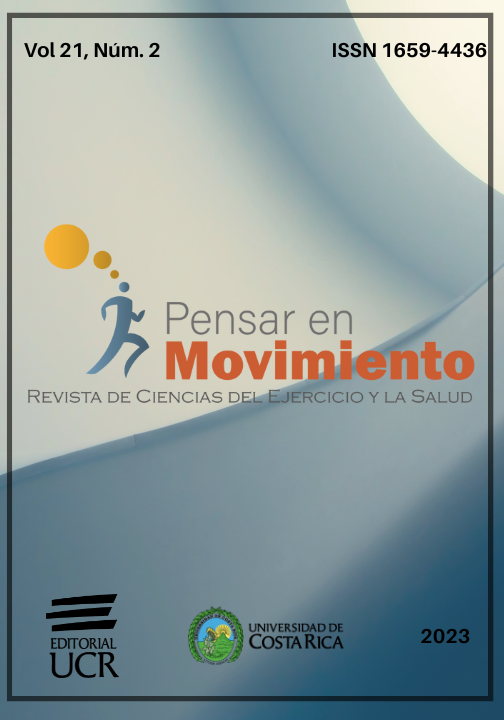Resumen
La altura del salto se sigue usando ampliamente para predecir la potencia en seres humanos. El progreso individual, a menudo, se monitorea usando una estimación de la potencia, pero las ecuaciones de predicción se basan en datos grupales. El estudio pretende demostrar que la altura del salto vertical (VJP) y la potencia mecánica tienen una pobre correlación, particularmente en un mismo individuo. Se presentan dos experimentos; primero, 52 estudiantes universitarios físicamente activos ejecutaron cinco saltos verticales máximos cada uno; segundo, tres participantes masculinos ejecutaron 50 saltos máximos cada uno. Los participantes descansaron 1 minuto entre saltos. VJP se calculó a partir de los datos cinemáticos como posición más alta del centro de masa corporal (BCOM) menos BCOM de pie; la potencia pico (PEAKPWR) se calculó a partir de la fuerza vertical de reacción registrada por una plataforma de fuerza y la potencia promedio (MEANPWR) durante la propulsión a partir del cambio en la energía potencial del BCOM. Se realizaron análisis de regresión usando puntajes estandarizados de VJP como la variable predictora y puntajes estandarizados de potencia como las variables resultantes, con la expectativa de obtener una función de identidad y = x (intercepto = 0, pendiente = 1) y R2 = 1. En el experimento 1, el modelo para zPEAKPWR arrojó R2 = 0.9707 (p <.0001) pero la pendiente (0.3452) ≠ 1 (p = 8.7x10-15). El modelo para zMEANPWR dio R2 = 0.9239 (p < .0001); sin embargo, la pendiente (0.4257) ≠ 1 (p = 1.15x10-5). En el experimento 2, todos los modelos individuales para zPEAKPWR y zMEANPWR arrojaron asociaciones débiles (R2 ≤ 0.21) y pendientes ≠ 1 (p ≤ .001). En conclusión, el análisis de regresión para individuos y aún para grupos confirma que la altura de salto vertical es un pobre predictor de la potencia mecánica.
Citas
Aragón-Vargas, L.F. (2000). Evaluation of Four Vertical Jump Tests: Methodology, Reliability, Validity and Accuracy. Measurement in Physical Education and Exercise Science, 4(4), 215–228. https://doi.org/10.1207/S15327841MPEE0404_2
Aragón-Vargas, L. F., y González-Lutz, M. I. (2023a). Dataset for experiment 1 of A novel validation approach shows new, solid reasons why vertical jump height should not be used to predict leg power. Pensar en Movimiento: Revista de Ciencias del Ejercicio y la Salud, 21(2). https://doi.org/10.15517/pensarmov.v21i2.56206
Aragón-Vargas, L. F., y González-Lutz, M. I. (2023b). Dataset for experiment 2 of A novel validation approach shows new, solid reasons why vertical jump height should not be used to predict leg power. Pensar en Movimiento: Revista de Ciencias del Ejercicio y la Salud, 21(2). https://doi.org/10.15517/pensarmov.v21i2.56208
Aragón-Vargas, L.F., y Gross, M.M. (1997a). Kinesiological factors in vertical jump performance: Differences among individuals. Journal of Applied Biomechanics, 13(1), 24–44. https://doi.org/10.1123/jab.13.1.24
Aragón-Vargas, L.F., y Gross, M.M. (1997b). Kinesiological factors in vertical jump performance: Differences within individuals. Journal of Applied Biomechanics, 13(1), 45–65. https://doi.org/10.1123/jab.13.1.45
Bar-Or, O. (1987). The Wingate anaerobic test. An update on methodology, reliability and validity. Sports Medicine, 4(6), 381–394. https://doi.org/10.2165/00007256-198704060-00001
Barquero, J. F., y Salazar, W. (2020). Efecto agudo de los entrenamientos de fuerza, velocidad, pliometría y velocidad contra resistencia en la carrera de velocidad . Pensar en Movimiento: Revista de Ciencias del Ejercicio y la Salud, 18(2), e40315. https://doi.org/10.15517/pensarmov.v18i2.40315
Bosco, C., Luhtanen, P., y Komi, P.V. (1983). A simple method for measurement of mechanical power in jumping. European Journal of Applied Physiology and Occupational Physiology, 50(2), 273–282. https://doi.org/10.1007/BF00422166
Canavan, P. K., y Vescovi, J. D. (2004). Evaluation of Power Prediction Equations: Peak Vertical Jumping Power in Women. Medicine & Science in Sports & Exercise, 36(9), 1589–1593. https://doi.org/10.1249/01.MSS.0000139802.96395.ac
Del Coso, J. D., y Mora-Rodríguez, R. (2006). Validity of cycling peak power as measured by a short-sprint test versus the Wingate anaerobic test. Applied Physiology, Nutrition, and Metabolism = Physiologie Appliquee, Nutrition Et Metabolisme, 31(3), 186–189. https://doi.org/10.1139/h05-026
Harman, E., Rosenstein, M., Frykman, P., Rosenstein, R., y Kraemer, W. (1991). Estimation of Human Power Output from Vertical Jump. https://www.semanticscholar.org/paper/Estimation-of-Human-Power-Output-from-Vertical-Jump-Harman-Rosenstein/47eeda520e5a2595392064a2faaf93909323751e
Hatze, H. (1998). Validity and Reliability of Methods for Testing Vertical Jumping Performance. Journal of Applied Biomechanics, 14(2), 127–140. https://doi.org/10.1123/jab.14.2.127
Jiménez-Reyes, P., Samozino, P., Pareja-Blanco, F., Conceição, F., Cuadrado-Peñafiel, V., González-Badillo, J. J., y Morin, J.-B. (2017). Validity of a Simple Method for Measuring Force-Velocity-Power Profile in Countermovement Jump. International Journal of Sports Physiology and Performance, 12(1), 36–43. https://doi.org/10.1123/ijspp.2015-0484
Kirkendall, D. R., Gruber, J. J., y Johnson, R. E. (1987). Measurement and evaluation for physical educators. Human Kinetics. https://library.olympics.com/Default/doc/SYRACUSE/67952/measurement-and-evaluation-for-physical-educators-don-r-kirkendall-joseph-j-gruber-robert-e-johnson
Lara-Sánchez, A. J., Zagalaz, M. L., Berdejo-del-Fresno, D., y Martínez-López, E. J. (2011). Jump Peak Power Assessment Through Power Prediction Equations in Different Samples. The Journal of Strength & Conditioning Research, 25(7), 1957–1962. https://doi.org/10.1519/JSC.0b013e3181e06ef8
Mann, T. (2011). Mean response disregards the importance of individual variation. South African Journal of Sports Medicine, 23(1), 30. https://doi.org/10.17159/2078-516X/2011/v23i1a532
Mann, T. N., Lamberts, R. P., y Lambert, M. I. (2014). High responders and low responders: Factors associated with individual variation in response to standardized training. Sports Medicine, 44(8), 1113–1124. https://doi.org/10.1007/s40279-014-0197-3
Morin, J.-B., Jiménez-Reyes, P., Brughelli, M., y Samozino, P. (2019). When Jump Height is not a Good Indicator of Lower Limb Maximal Power Output: Theoretical Demonstration, Experimental Evidence and Practical Solutions. Sports Medicine, 49(7), 999–1006. https://doi.org/10.1007/s40279-019-01073-1
Rodríguez Zárate, N. M., Argothy Bucheli, R. E., Acero Jáuregui, J. A., Gómez Salazar, L., Menzel, H., y Cohen, D. D. (2018). Lineamiento de política pública en ciencias del deporte en Biomecánica. Coldeportes. https://acortar.link/Y8dpff
Samozino, P., Morin, J.-B., Hintzy, F., y Belli, A. (2008). A simple method for measuring force, velocity and power output during squat jump. Journal of Biomechanics, 41(14), 2940–2945. https://doi.org/10.1016/j.jbiomech.2008.07.028
Sayers, S. P., Harackiewicz, D. V., Harman, E. A., Frykman, P. N., y Rosenstein, M. T. (1999). Cross-validation of three jump power equations. Medicine & Science in Sports & Exercise, 31(4), 572–577. https://doi.org/10.1097/00005768-199904000-00013.
Tessier, J.-F., Basset, F.-A., Simoneau, M., y Teasdale, N. (2013). Lower-Limb Power cannot be Estimated Accurately from Vertical Jump Tests. Journal of Human Kinetics, 38(2013), 5–13. https://doi.org/10.2478/hukin-2013-0040
##plugins.facebook.comentarios##

Esta obra está bajo una licencia internacional Creative Commons Atribución-NoComercial-CompartirIgual 4.0.
Derechos de autor 2023 Luis Fernando Aragón-Vargas, María Isabel González-Lutz







